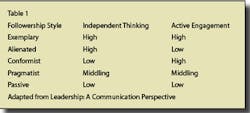Learning from the Lost Boys
by Kelli Swanson Jaecks, RDH, BSDH
Leadership has gained a much-appreciated forum in dental hygiene publications. If we are to achieve the personal and professional goal of being recognized as the preventive oral health-care specialists, many of us will need to step up and assume leadership roles in our communities, practices, and associations. Toni Adams recently had an excellent article in Sept. 2006 RDH titled, “Follow the Leader.” I’d like to provide a follow-up to her insightful ideas on leadership by contrasting it to the flip side of leadership - followership.
Remember Walt Disney’s Peter Pan? The lost boys chanted to Peter, “Following the leader, the leader, the leader, we’re following the leader, wherever he may go.” Whatever Peter would do, the lost boys replicated. Peter engaged in different activities like walking a straight line, jumping on one foot, and uttering silly syllables, and the followers copied. This is a sweet memory of innocence and game-playing, but definitely not an apt description of leaders and followers in today’s businesses and communities.
If being a follower required only listening, watching, and acting like the leader, very little would get done. Conversely, if leaders only demanded exact replication of thoughts and action, we might as well return to the stifling world of The Stepford Wives. Today, leaders and followers need to engage in critical thinking together to voice innovative ideas and work toward achieving common goals. Today’s environment calls for a better understanding of leaders and followers, their respective roles, and how they can effectively work together.
While leadership is a seemingly ubiquitous term seen everywhere these days, followership is rarely addressed. It stands to reason that there is no leader without followers, and no leader can accomplish much of anything without followers. An effective definition of followership from the world of business is:
A follower is one who pursues a course of action in common with a leader to achieve an organizational goal. Effective followers make an active decision to contribute towards the achievement of the goal and demonstrate enthusiasm, intelligence, self-reliance and the ability to work with others in pursuit of the goal.1
Leadership styles usually fall somewhere along the continuum of authoritarian, democratic, or laissez-faire. Some people are goal-oriented, preferring tasks with more personal control and input. Others are team-oriented, where leadership comes most naturally when working in tandem with someone else. Just as people differ in leadership styles, so do they differ in followership styles. Take a look at the groups you are involved in and the leaders you follow. Why do you follow them? What is it about their style that attracts you?
Types of followers
Hackman and Johnson, in their book, Leadership: A Communication Perspective,2 say followers differ on two dimensions: independent critical thinking and active engagement. Followers who are self-motivated, contribute innovative ideas, and go beyond what is required of them are termed exemplary. We see these types of followers who are actively making gains toward their goals and objectives.
A good working example of this type of followership is seen in our professional organization, the ADHA. Strong leadership teams on the national level provide clear action steps on implementing strategies and meeting goals. Members work to implement these strategies and goals, and we see new relationships and new areas of progress and change. There are numerous examples within the ADHA of followers going beyond what is required of them to get things done. Both followers and leaders take ownership of the outcomes and contribute what they can to the group’s goals.
Some people are more passive or conformist followers. They agree with the goals of the group, but tend to do only what is asked of them and rely heavily on the leader’s input and direction. These followers need more encouragement and personal involvement from the leader. Their contributions are still valuable, and with some concrete instructions, they can generally be relied upon to get the job done. Passive followers are great “go to” people when the leaders have a very specific task with clear parameters and guidelines.
Pragmatist or alienated followers work only to serve themselves and often act contrary to the group’s goals. These followers usually operate out of disillusionment or feelings of being underappreciated. They may not understand or align themselves with the leader or group. Perhaps you have known hygienists who are members of ADHA, but who had issues with a certain leader’s style or focus, and thus did not get involved. Or perhaps a member of your group always “goes against the grain” and creates tension and conflict within the group. This person would have better success following a different leader, or the leader may be able to reduce this tension by focusing on the follower’s unmet needs and desires.
This is not to say that opposing opinions or insights are not welcome; in fact, it is often the disillusioned critical thinker who brings a new and innovative idea to the table. Again, it is the process of leaders and followers working together and respecting each other that brings success and active attainment of group goals.
The basic questions regarding your followership style are: To what level do you work under your own initiative? How comfortable are you with self-direction? How much input and guidance do you prefer from a leader? Do you prefer working alone or on teams? Do you feel comfortable voicing your ideas and concerns? What kind of leader makes you the most happy and fulfilled? See Table 1 to determine your followership style.
Followers are very powerful; they help determine if a leader is effective and successful. Followership can be very active and fulfilling. It is the relationship between the leader and follower that creates either a dynamic work/organization environment, or leads to separation and discontent.
The leader/follower relationship must be reciprocal. As leaders and followers work together, does the follower see his or her goals being achieved, see an increase in knowledge, and see him or herself becoming more autonomous? Is the follower acting out of his or her own convictions and ethics while serving the greater vision? Are leadership traits recognized and fostered in the follower? Is the leader/follower relationship a win/win for both parties? If so, we have a recipe for success and fulfillment on many levels.
In a satisfying situation, followers are more apt to use their intellect to figure out problems, act independently without being told every move, and operate with confidence and strong ethics. This type of follower can see holes or weaknesses in the leader and can help fill in the gaps, which results in a stronger team and organization.
We need both leaders and followers to be effective in our achievements. Discovering how we work best and where we thrive as followers will bring personal and team fulfillment. Throughout our lives we will operate on different levels in the role of both leader and follower.
In the ADHA, we see these partnerships operating on the national and state levels in our boards, councils, components, and committees. Sometimes you may be the leader and sometimes a follower. How we work together in these roles will determine our future success both personally and professionally. A worthy goal in these roles is to work together for mutual satisfaction and gain.
With this new light on followership, I ask: “Follow the leader, anyone?”
References
1 Walsh A. Followership: the case for promoting followership in business. Adrian Walsh and Associates, Ltd. 2003. Accessed Feb. 27, 2007, from http://adrianwalsh.com.au/followership.htm.
2 Hackman MK, Johnson CE. Leadership: a communication perspective (4th ed). Long Grove, Ill., Waveland Press, Inc. 2004.
Additional resource
• Jacobsen R. Leading for a change: how to master the challenges faced by every leader. Woburn Mass., Butterworth-Heinemann 2000. Accessed Dec. 18, 2006, from http://www.amazon.com/Leading-Change-Master-Challenges-Leader/dp/075067279X.
Kelli Swanson Jaecks, RDH, BS, is pursuing a master’s degree from Oregon State University in communication and adult education. She is currently teaching leadership and public speaking at OSU. Kelli is an active leader in the Oregon Dental Hygienists’ Association, serving at the local, state and national levels. She holds a Limited Access Permit and is currently ODHA’s vice-president. Her passions include mentoring young leaders, building effective teams, and promoting health awareness to the public. She can be reached at [email protected]


